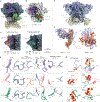Germline-targeting HIV vaccination induces neutralizing antibodies to the CD4 binding site
- PMID: 39213338
- PMCID: PMC11783328
- DOI: 10.1126/sciimmunol.adk9550
Germline-targeting HIV vaccination induces neutralizing antibodies to the CD4 binding site
Abstract
Eliciting potent and broadly neutralizing antibodies (bnAbs) is a major goal in HIV-1 vaccine development. Here, we describe how germline-targeting immunogen BG505 SOSIP germline trimer 1.1 (GT1.1), generated through structure-based design, engages a diverse range of VRC01-class bnAb precursors. A single immunization with GT1.1 expands CD4 binding site (CD4bs)-specific VRC01-class B cells in knock-in mice and drives VRC01-class maturation. In nonhuman primates (NHPs), GT1.1 primes CD4bs-specific neutralizing serum responses. Selected monoclonal antibodies (mAbs) isolated from GT1.1-immunized NHPs neutralize fully glycosylated BG505 virus. Two mAbs, 12C11 and 21N13, neutralize subsets of diverse heterologous neutralization-resistant viruses. High-resolution structures revealed that 21N13 targets the same conserved residues in the CD4bs as VRC01-class and CH235-class bnAbs despite its low sequence similarity (~40%), whereas mAb 12C11 binds predominantly through its heavy chain complementarity-determining region 3. These preclinical data underpin the ongoing evaluation of GT1.1 in a phase 1 clinical trial in healthy volunteers.
Conflict of interest statement
Competing interests
AC, PJK, JPM, IAW, ABW and RWS are inventors on a patent related to BG505 SOSIP Env trimers, and MMR and RWS are inventors on a patent related to germline-targeting HIV-1 Env trimers. SP is currently a full-time employee of Moderna, Inc. FDB has consultancy relationships with Adimab, Third Rock Ventures, and The EMBO Journal.
Figures






References
-
- Julg B, Liu P-T, Wagh K, Fischer WM, Abbink P, Mercado NB, Whitney JB, Nkolola JP, McMahan K, Tartaglia LJ, Borducchi EN, Khatiwada S, Kamath M, LeSuer JA, Seaman MS, Schmidt SD, Mascola JR, Burton DR, Korber BT, Barouch DH, Protection against a mixed SHIV challenge by a broadly neutralizing antibody cocktail. Sci. Transl. Med. 9, (2017). - PMC - PubMed
-
- Corey L, Gilbert PB, Juraska M, Montefiori DC, Morris L, Karuna ST, Edupuganti S, Mgodi NM, deCamp AC, Rudnicki E, Huang Y, Gonzales P, Cabello R, Orrell C, Lama JR, Laher F, Lazarus EM, Sanchez J, Frank I, Hinojosa J, Sobieszczyk ME, Marshall KE, Mukwekwerere PG, Makhema J, Baden LR, Mullins JI, Williamson C, Hural J, McElrath MJ, Bentley C, Takuva S, Gomez Lorenzo MM, Burns DN, Espy N, Randhawa AK, Kochar N, Piwowar-Manning E, Donnell DJ, Sista N, Andrew P, Kublin JG, Gray G, Ledgerwood JE, Mascola JR, Cohen MS, Two Randomized Trials of Neutralizing Antibodies to Prevent HIV-1 Acquisition. N. Engl. J. Med. 384, 1003–1014 (2021). - PMC - PubMed
Publication types
MeSH terms
Substances
Grants and funding
LinkOut - more resources
Full Text Sources
Research Materials

